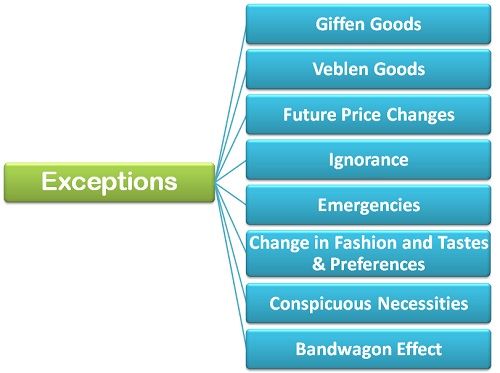Definition: There are certain situations where the law of demand does not apply or becomes ineffective, i.e. with a fall in the price the demand falls and with the rise in price the demand rises are called as the exceptions to the law of demand.
Exceptions to the Law of Demand
- Giffen Goods: Giffen goods are the inferior goods whose demand increases with the increase in its prices. There are several inferior commodities, much cheaper than the superior substitutes often consumed by the poor households as an essential commodity. Whenever the price of the Giffen goods increases its quantity demanded also increases because, with an increase in the price, and the income remaining the same, the poor people cut the consumption of superior substitute and buy more quantities of Giffen goods to meet their basic needs.
For Example,
Suppose the minimum monthly consumption of food grains by a poor household is 20 Kg Bajra (Inferior good) and 10 Kg Rice (superior good). The selling price of Bajra is Rs 5 per kg, and the rice is Rs 10 per kg, and the household spends its total income of Rs 200 on the purchase of these items. Suppose, the price of Bajra rose to Rs 6 per kg then the household will be forced to reduce the consumption of rice by 5 Kg and increase the quantity of Bajra to 25 Kg in order to meet the minimum monthly requirement of food grains of 30 kg. - Veblen Goods: Another exception to the law of demand is given by the economist Thorstein Veblen, who proposed the concept of “Conspicuous Consumption.” According to Veblen, there are a certain group of people who measure the utility of the commodity purely by its price, which means, they think that higher priced goods and services derive more utility than the lesser priced commodities.
For example
, goods like a diamond, platinum, ruby, etc. are bought by the upper echelons of the society (rich class) for whom the higher the price of these goods, the higher is the prestige value and ultimately the higher is the utility or desirability of them. - Expectation of Price Change in Future: When the consumer expects that the price of a commodity is likely to further increase in the future, then he will buy more of it despite its increased price in order to escape himself from the pinch of much higher price in the future.
On the other hand, if the consumer expects the price of the commodity to further fall in the future, then he will likely postpone his purchase despite less price of the commodity in order to avail the benefits of much lower prices in the future.
- Ignorance: Often people are misconceived as high-priced commodities are better than the low-priced commodities and rest their purchase decision on such a notion. They buy those commodities whose price are relatively higher than the substitutes.
- Emergencies: During emergencies such as war, natural calamity- flood, drought, earthquake, etc., the law of demand becomes ineffective. In such situations, people often fear the shortage of the essentials and hence demand more goods and services even at higher prices.
- Change in fashion and Tastes & Preferences: The change in fashion trend and tastes and preferences of the consumers negates the effect of law of demand. The consumer tends to buy those commodities which are very much ‘in’ in the market even at higher prices.
- Conspicuous Necessities: There are certain commodities which have become essentials of the modern life. These are the goods which consumer buys irrespective of an increase in the price. For example TV, refrigerator, automobiles, washing machines, air conditioners, etc.
- Bandwagon Effect: This is the most common type of exception to the law of demand wherein the consumer tries to purchase those commodities which are bought by his friends, relatives or neighbors. Here, the person tries to emulate the buying behavior and patterns of the group to which he belongs irrespective of the price of the commodity.
For example
, if the majority of group members have smart phones then the consumer will also demand for the smartphone even if the prices are high.
Thus, these are some of the exceptions to the law of demand where the demand curve is upward sloping, i.e. the demand increases with an increase in the price and decreases with the decrease in price.


Jisna says
Very nice explanation, Thank you.
AMON.N.W says
I love this, well spelt out.
Stanley Mawuli says
I love the explanations and examples bigup to you